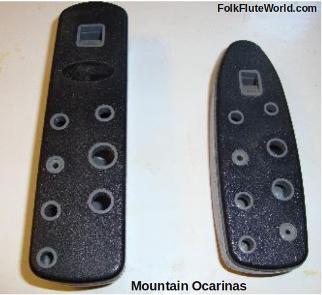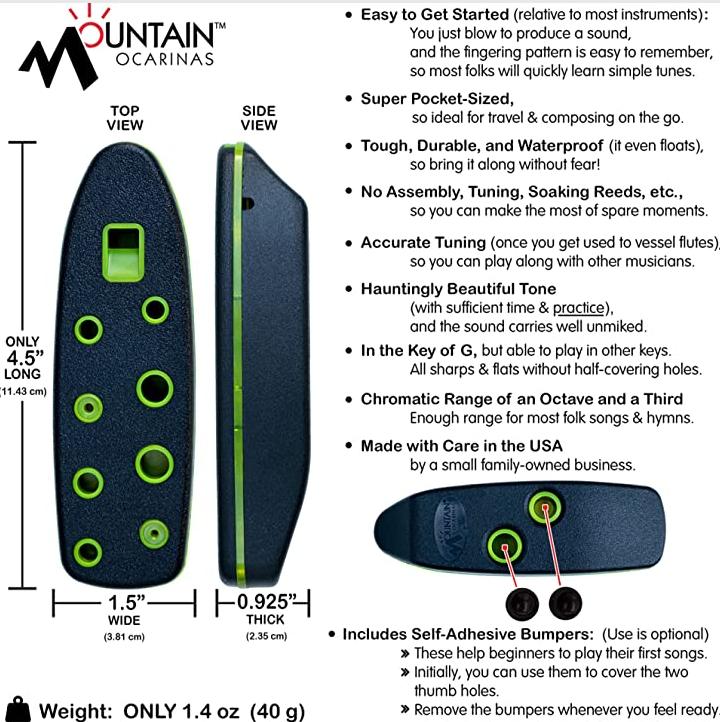by Howard Fosdick © FolkFluteWorld.com.
This review covers two ocarinas made by the company Mountain Ocarinas. Both are rectangular-shaped, rather like TV remotes. They extend straight from your mouth when you play them. They are thus called inline ocarinas.
Mountain Ocarinas offers their inline oc's in two keys, as shown in this photo:

The larger ocarina on the left is in the key of C major, while the smaller one to its right is in G major. The lowest note of the larger oc is thus the same as that of the soprano recorder. The lowest note of the smaller G ocarina sounds several notes higher.
This reviews tells you everything you need to know about these MO (Mountain Ocarinas) ocarinas.
What's Available Varies
Let's start with two important facts. First, Mountain Ocarinas is a small, family-run business. Its ocarinas are all designed by its owner, Karl Ahrens. Mr. Ahrens is well-known in the ocarina community as an innovator who has contributed strikingly original, thoughtful designs.
Being a small family business, MO produces their various oc's off and on, and in several different materials. You'll have to check the MO website or Amazon to see exactly what is available when you read this review.
For example, as I write this, MO sells both the C and G inlines in a high-quality instrumental plastic (called "polycarbonate" or just "poly"). At other times, MO has sold them in other materials. And sometimes, they're "out of stock" and don't sell any at all.
Of course, you can always search the used market at Ebay or other shops if you want to buy a particular MO variety not currently sold by the vendor.
Second fact: MO also produces the Everyday Carry Flute. Also known as the EDC Flute, the EDC's big advantage is its extended range. While the MO oc's reviewed in this article have a range of about an octave plus 3 whole notes, the EDC Flute ranges across two full octaves.
I love my EDC Flute, and you can find my review of it here. Some people consider it a superior replacement for the two original MO oc's in this review. I don't. I think each variety has its own unique characteristics and benefits. So, I still play my original MO oc's. They're simple and offer great sound. Hence, this review.
The Basics
Mountain Ocarinas has manufactured these two oc's in several different materials over the years. Among them are polycarbonate plastic, warmstone, cocobolo wood, and aluminum.
The larger instrument is in the key of C major. It measures about 5" long and about 1 1/2" wide. It has 7 top holes and two thumbs holes beneath, for a range from C5 to E6. That's 10 whole notes, plus all intervening sharps and flats. (If you're pretty skilled, you might be able get an extra low note or two -- B# or B -- below the low C by blowing very softly.)
The smaller instrument is keyed to G major. It measures about 4 1/2" long and up to almost 1 1/2" inches wide at its widest point. With 8 top holes and two thumb holes beneath, it ranges from F#5 to B6. That's a range of 10 whole notes, plus low F# beneath them. (Again, a skilled player might even be able to sound an F below the F#.)
The lowest note of the C major oc is the same as that of the soprano recorder, while the G instrument's key is four notes higher. Note that since the G ocarina has the one extra finger hole (see the above photo) it plays down to a note below G.
You finger these inline oc's identically to how you play any standard transverse (sweet potato or submarine) ocarina -- except for one quirk. The use of the two thumb holes beneath the instrument are reversed versus that you find for most ocarinas. If you play other oc's a lot this quirk takes a session or two to get used to.
These instruments weigh just a few ounces. Along with their rounded edges and great durability, this makes them perfect for pocket carry. They're rugged and lightweight.
Both instruments come with a neck strap, fingering charts, and handy instructional booklet with several songs to get you started.
Sound
The beauty of folk flutes is that they're so inexpensive. I have an entire set of ocarinas, tin whistles, and a few low-end recorders, for a total cost of less than that of one good concert flute.
Nevertheless, these simple instruments can sound beautifully.
Here's how the MO oc's sound at Youtube:
Obviously, these are highly skilled musicians. Yet I find these instruments sound very appealing even in the hands of an everyday player like myself.
Being plastic inlines, my two MO oc's do sound a bit different than traditional ceramic transverse ocarinas. I like having these different sounds available for different moods or different kinds of music.
Some aficionados claim they can hear a tonal difference between the different materials of the MO oc's -- poly plastic, warmstone, wood, and aluminum -- but to my ear, they all sound highly similar. In a blind test, I think I can distinguish the plastic C version from its counterparts. I think perhaps the warmstone material sounds a little fuller or less like plastic to my ear. I detect no difference between materials for the G ocarina. Other people may be able to detect the subtle tonal differences better than I.
One final note: high-pitched ocarinas generally sound louder than lower ones. This is certainly true here. Played at the appropriate breath pressure, the G definitely sounds louder than the C. The G is thus well-suited to outdoor play. For inside, I prefer the softer-sounding C.
Advantages
The MO oc's have several key advantages over other kinds of ocarinas and folk flutes.First, they're nearly indestructible. Regardless of which material you choose, you can drop these things, get them wet, carry them without a protective case, and stuff them in your pocket.
It doesn't matter. You can't hurt them. I find this perfect for outdoor use, at the beach and when I go camping. It's music on the go without the worries you have with an expensive, delicate instrument like a concert flute. Their portability stems directly from their durability.
Second, these oc's are simple to play. Way simpler than concert instruments like the clarinet or sax or flute. Yes, they're musically limited -- especially in their range -- but simplicity has its benefits. I've found I can play almost any tune with them. Just make sure you select a key that keeps the song within range for the instrument.
Third, these ocarinas sound wonderful. Even simple flutes can give you great sound. Play in a stairwell or basement for some natural resonance, and you can make these little oc's sound ethereal.
Lastly, whether it's these two MO products or other ocarinas, there are a ton of free resources available on the web.
- For our extensive list of free sheet music, click here.
- For Youtube lessons, tips, and more, click here.
- You can find even more free resources by clicking here.
- To take a look at the MO fingering charts for C and G, click here.
The bottom line: You don't need to buy a thing beyond the ocarina itself. Everything you need to learn this instrument and play it is available online for free.
Final Words
Many fans of the Mountain Ocarina products have moved on to the highly-capable EDC Coda. I love it, too.
But I still play my original MO oc's as well. They sound lovely, yet they're portable and durable. What's not to love?
For more information and many more opinions on these MO oc's, check out this discussion, this one and this one on The Ocarina Network.
**** SUMMARY ****
Style: Inline ocarinasMaterial: Several including polycarbonate plastic, warmstone, aluminum
Website: Mountain Ocarinas
Where to Buy:The MO or Amazon websites. Or on the used market, such as at Ebay or Etsy
Pitch: C model is C5-E6 (10 whole notes), G model is F#5-B6 (10 whole notes plus one)
Chromatics: Plays all sharps and flats
Holes: C model has 7 top holes and two thumbs holes beneath, G model has 8 top holes and two thumb holes underneath
Dimensions: C model is 5" long and about 1 1/2" wide, G model is 4 1/2" long and up to almost 1 1/2" inches wide at its widest point
Weight: C model is 2.89 ounces, G model is 2.08 ounces
Cost: Varies. Currently about $40 USD new

Courtesy of Mountain Ocarinas